Exercises (2276)
Lunge backwards (left) ► dumbbell reverse lunge
Power
Individual work
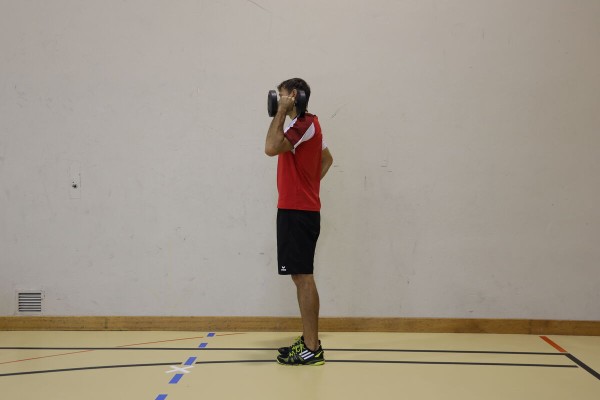
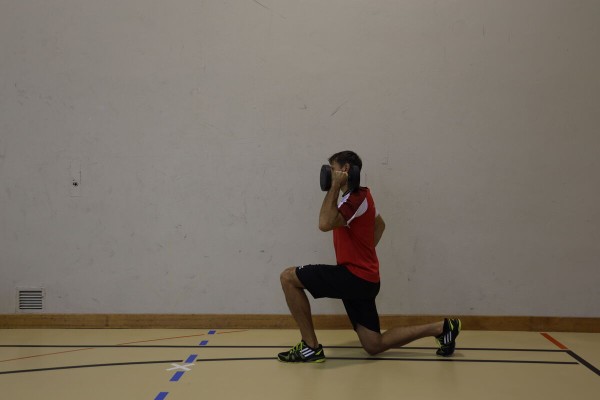
Stand upright shoulder-width apart, one arm (right) hanging beside the body, the left arm bent and holding the weight in your hand (dumbbell, kettlebell or medicine ball) so that the weight is next to your head at ear level (place the medicine ball on your shoulder). At the same time, bend the (front left) standing leg to approximately a right angle in the knee joint, then straighten the front leg (left) and bring the back leg (right) forwards again to return to the starting position.
Attention:
Upright posture, front knee always remains behind the tip of the foot and centred over the foot.
Lighten:
Lower the upper body less (greater angle in the knee)/lean the leg back less; hold less or no weight in the hands.
Harden:
More weight; additional weight.
1 dumbbell/kettlebell/medicine ball
1 weight waistcoat ► to make the exercise more difficult (additional weight)
Lunge backwards (left) ► reverse lunge
Power
Individual work


Lunge frontally towards the (rung) wall, the hands support the slightly forward leaning upper body at chest height on the wall, front (right) leg bent, the back (left) leg is placed on a slippery surface, push the free leg (left) as straight as possible backwards/push it out and lead it back forwards to the starting position.
Attention:
Keep your posture upright.
Lighten:
Less wide extension of the free leg.
Harden:
Instable base for the supporting leg.
1 wall bars/wall
1 carpet remnant/felt slipper/glider
1 ball/balance cushion/balance board ► make the exercise more difficult (unstable surface)
Lunge backwards (left) ► reverse lunge
Power
Individual work


Stand upright with your feet shoulder-width apart, arms supported on your hips or in front of you, place one foot (left) on a slippery surface, slowly move the free leg (left) back, simultaneously bend the front leg (right) to approximately a right angle at the knee joint, then bring the legs back together to the starting position for standing.
Attention:
Upright posture, front knee always remains behind the tip of the foot and centred over the foot.
Lighten:
Lower the upper body less (greater angle in the knee)/less wide extension of the free leg.
Harden:
Additional weight (hold on the shoulders/in the hands); unstable base for the supporting leg.
1 carpet remnant/felt slipper/glider
1 weight vest/sandbag/barbell/2 dumbbells ► to make the exercise more difficult (additional weight)
1 ball/balance cushion ► to make the exercise more difficult (unstable surface)
Lunge backwards (left) ► reverse lunge
Power
Individual work

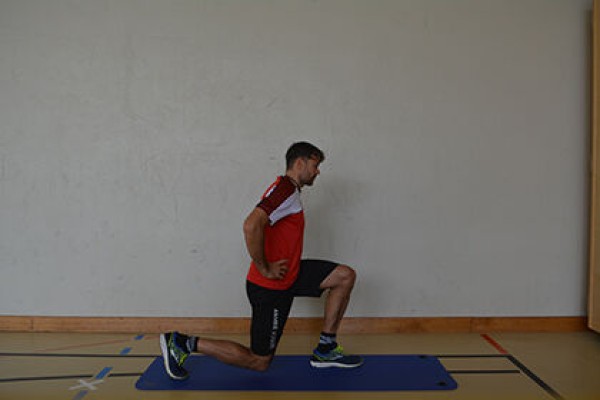
Stand upright, feet shoulder-width apart, rest your arms on your hips or in front of you, move one foot (right) backwards and place it on the front foot, simultaneously bend the (front) standing leg (left) at the knee joint approximately at a right angle, then stretch the front leg (left) and move the back leg (right) forwards again to return to the starting position.
Attention:
The right, front knee always remains behind the toe and centred over the foot.
Lighten:
Lower the upper body less (greater angle in the knee)/lead the free leg less far back.
Harden:
Additional weight (hold on shoulders/hands).
1 weight vest/sandbag/barbell/2 dumbbells ► make the exercise more difficult (additional weight)
Lunge backwards (right)
Power
Individual work


Stand upright with your feet shoulder-width apart, arms supported on your hips or in front of you, place one foot (right) on a slippery surface, slowly move the free leg (right) back, simultaneously bend the front leg (left) to approximately a right angle at the knee joint, then bring the legs back together to the starting position for standing.
Attention:
Upright posture, front knee always remains behind the tip of the foot and centred over the foot.
Lighten:
Lower the upper body less (greater angle in the knee)/less wide extension of the free leg.
Harden:
Additional weight (hold on the shoulders/in the hands); unstable base for the supporting leg.
1 carpet remnant/felt slipper/glider
1 weight vest/sandbag/barbell/2 dumbbells ► to make the exercise more difficult (additional weight)
1 ball/balance cushion ► to make the exercise more difficult (unstable surface)
Lunge backwards (right) ► dumbbell reverse lunge
Power
Individual work
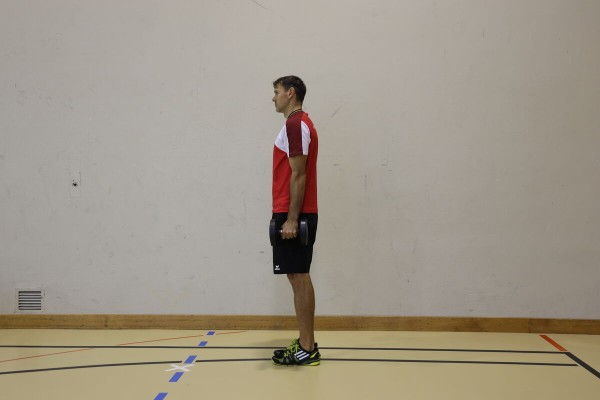
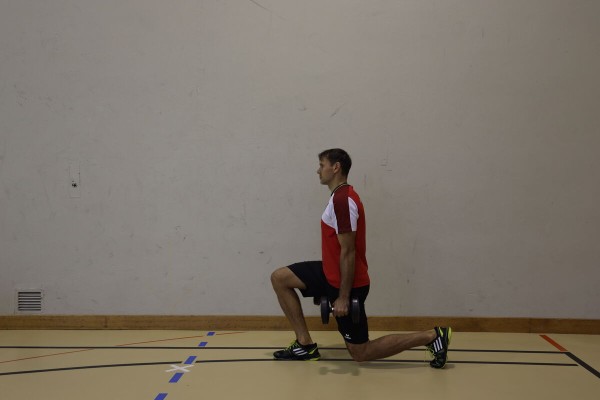
Stand upright shoulder-width apart, arms hanging next to the body, holding the weight (dumbbell or kettlebell) with each hand, move one foot (left) backwards and place it on the front foot, simultaneously bend the (front right) standing leg to approximately a right angle in the knee joint, then straighten the front leg (right) and move the back leg (left) forwards again to return to the starting position.
Attention:
Upright posture, front knee always remains behind the tip of the foot and centred over the foot.
Lighten:
Lower the upper body less (greater angle in the knee)/lean back less; hold less or no weight in the hands.
Harden:
More weight; additional weight.
Variation:
While bending the front leg, bend the arms at the same time for additional training of the upper body (arm flexors). While stretching the leg, also return the arms to the starting position.
2 dumbbells/kettlebells
1 weight waistcoat ► to make the exercise more difficult (additional weight)
Lunge backwards (right) ► dumbbell reverse lunge
Power
Individual work
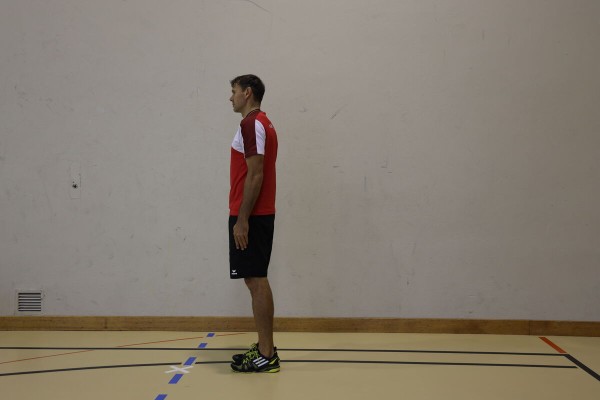
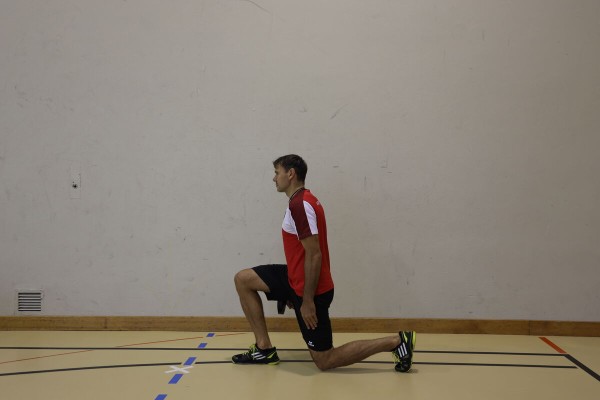
Stand upright shoulder-width apart, arms hanging beside the body, holding the weight (dumbbell or kettlebell) in the right hand, move one foot (left) backwards and place it on the front foot, simultaneously bend the (front right) standing leg to approximately a right angle in the knee joint, then straighten the front leg (right) and move the back leg (left) forwards again to return to the starting position.
Attention:
Upright posture, front knee always remains behind the tip of the foot and centred over the foot.
Lighten:
Lower the upper body less (greater angle in the knee)/lean back less; hold less or no weight in the hands.
Harden:
More weight; additional weight.
Variation:
While bending the front leg, simultaneously bend the arm with the weight in your hand for additional training of the upper body (arm flexors). While stretching the leg, also return the arm to the starting position.
1 dumbbell/kettlebell
1 weight waistcoat ► to make the exercise more difficult (additional weight)
Lunge backwards (right) ► dumbbell reverse lunge
Power
Individual work
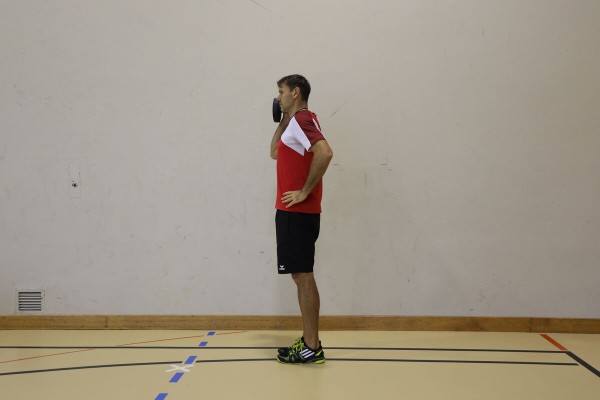
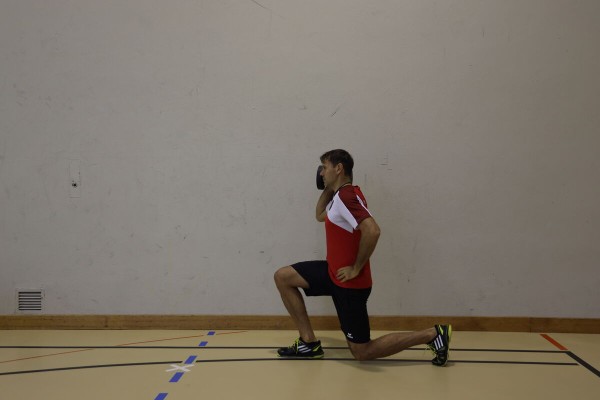
Stand upright shoulder-width apart, one arm (left) hanging next to the body, the right arm bent and holding the weight in your hand (dumbbell, kettlebell or medicine ball) so that the weight is next to your head at ear level (place the medicine ball on your shoulder). At the same time, bend the (front right) standing leg to approximately a right angle in the knee joint, then straighten the front leg (right) and bring the back leg (left) forwards again to return to the starting position.
Attention:
Upright posture, front knee always remains behind the tip of the foot and centred over the foot.
Lighten:
Lower the upper body less (greater angle in the knee)/lean the leg back less; hold less or no weight in the hands.
Harden:
More weight; additional weight.
1 dumbbell/kettlebell/medicine ball
1 weight waistcoat ► to make the exercise more difficult (additional weight)
Lunge backwards (right) ► reverse lunge
Power
Individual work


Lunge frontally towards the (rung) wall, the hands support the slightly forward leaning upper body at chest height on the wall, front (left) leg bent, the back (right) leg is placed on a slippery surface, push the free leg (right) as straight as possible backwards/push it out and lead it back forwards to the starting position.
Attention:
Keep your posture upright.
Lighten:
Less wide extension of the free leg.
Harden:
Instable base for the supporting leg.
1 wall bars/wall
1 carpet remnant/felt slipper/glider
1 ball/balance cushion/balance board ► make the exercise more difficult (unstable surface)
Lunge backwards (right) ► reverse lunge
Power
Individual work


Stand to the side of the wall bars, hold on to the wall bars at chest height with the hand facing the wall bars, the leg facing the wall bars (left) is slightly bent, the other (right) leg is placed on a slippery surface, lead/spread the free leg (right) stretched out to the side as far as possible.
Attention:
Keep the upper body upright, keep the knee of the supporting leg centred over the foot, put weight on the whole foot.
Lighten:
Lower the side of the free leg.
Harden:
Do not hold on to the wall bars; unstable surface for the supporting leg.
1 wall bars
1 carpet remnant/felt slipper/glider
1 ball/balance cushion/balance board ► make the exercise more difficult (unstable surface)
Lunge backwards (right) ► reverse lunge
Power
Individual work


Stand upright with your feet shoulder-width apart, arms supported on your hips or in front of you, move one foot (left) backwards and place it on the front foot, simultaneously bend the (front) standing leg (right) to approximately a right angle in the knee joint, then straighten the front leg (right) and move the back leg (left) forwards again to return to the starting position.
Attention:
Upright posture, front knee always remains behind the tip of the foot and centred over the foot.
Lighten:
Lower the upper body less (greater angle in the knee)/lead the free leg less far back.
Harden:
Additional weight (hold on the shoulders/in the hands).
1 weight vest/sandbag/barbell/2 dumbbells ► make the exercise more difficult (additional weight)
Lunge backwards alternating ► dumbbell reverse lunge
Power
Individual work
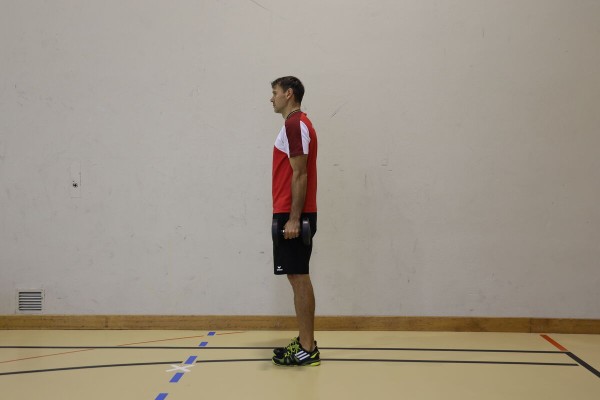
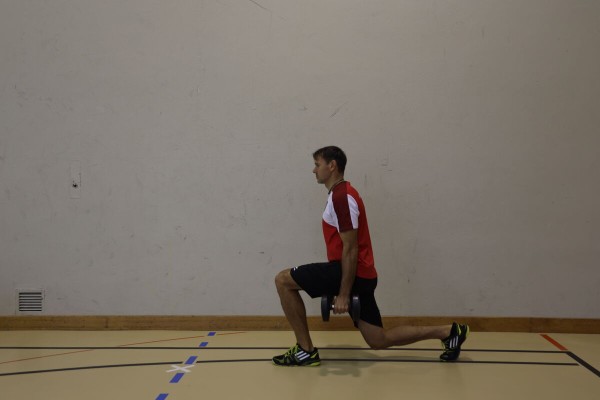
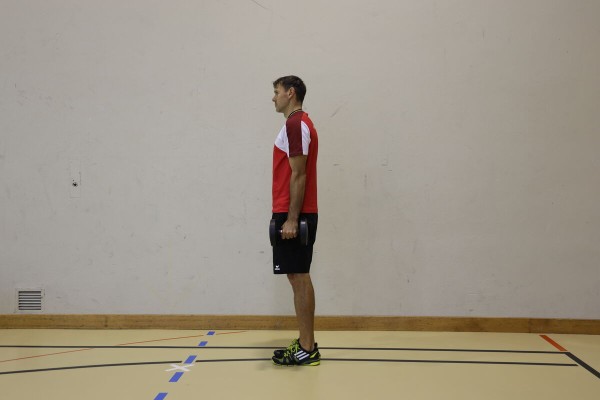
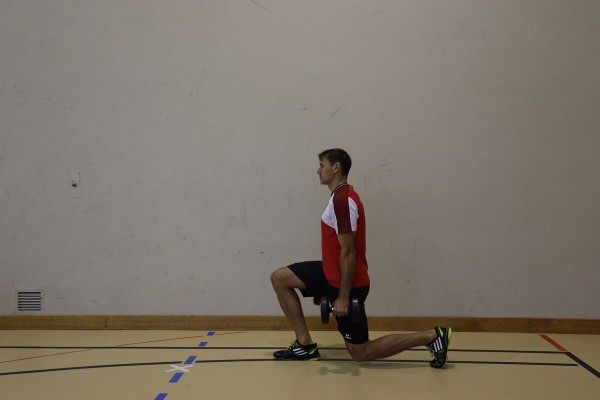
Stand upright shoulder-width apart, arms hanging next to the body, holding the weight (dumbbell or kettlebell) with each hand, move one foot backwards and place it on the front foot, simultaneously bend the (front) supporting leg to approximately a right angle in the knee joint, then straighten the front leg and move the back leg forwards again to return to the starting position. Change sides (the free leg that is moved backwards) after each execution.
Attention:
Upright posture, front knee always remains behind the tip of the foot and centred over the foot.
Lighten:
Lower the upper body less (greater angle in the knee)/lead the free leg less far backwards; hold less or no weight in the hands.
Harden:
More weight; additional weight.
Variation:
While bending the front leg, bend the arms at the same time for additional training of the upper body (arm flexors). While stretching the leg, also return the arms to the starting position.
2 dumbbells/kettlebells
1 weight waistcoat ► to make the exercise more difficult (additional weight)
Lunge backwards alternating ► reverse lunge
Power
Individual work



Stand upright with your feet shoulder-width apart, arms supported on your hips or in front of you, bring one foot back and place it on the front foot, simultaneously bend the (front) supporting leg to approximately a right angle in the knee joint, then straighten the front leg and bring the back leg forwards again to return to the starting position. Switch sides (the free leg that is moved backwards) after each exercise.
Attention:
Upright posture, front knee always remains behind the tip of the foot and centred over the foot.
Lighten:
Lower the upper body less (greater angle in the knee)/lean the leg less far back.
Harden:
Additional weight (hold on the shoulders/in the hands).
1 weight vest/sandbag/barbell/2 dumbbells ► make the exercise more difficult (additional weight)
Lunge sideways (left) ► lateral lunge
Power
Individual work
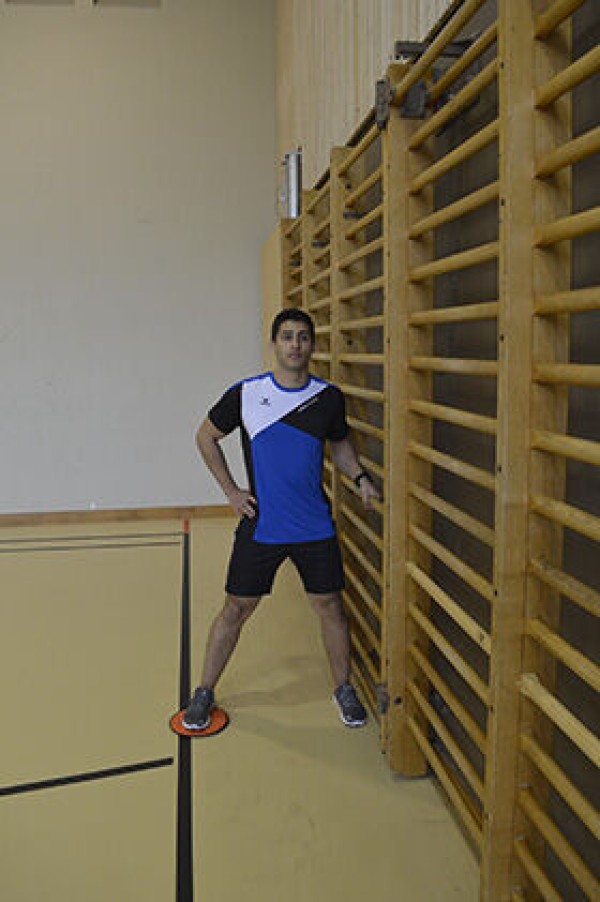

Stand to the side of the wall bars, hold on to the wall bars at chest height with the hand facing the wall bars, the leg facing the wall bars (right) is slightly bent, the other (left) leg is placed on a slippery surface, lead/spread the free leg (left) stretched out to the side as far as possible.
Attention:
Keep the upper body upright, keep the knee of the supporting leg centred over the foot, put weight on the whole foot.
Lighten:
Lower the side of the free leg.
Harden:
Do not hold on to the wall bars; unstable surface for the supporting leg.
1 wall bars/wall
1 carpet remnant/felt slipper/glider
1 ball/balance cushion/balance board ► make the exercise more difficult (unstable surface)
Lunge sideways (left) ► lateral lunge
Power
Individual work


From an upright shoulder-width stance with the dumbbells held in the hanging arms, perform a lunge to the (left) side (leg outstretched, supporting leg bent). Then push off the bent leg to return to the starting position in the standing position.
Starting position:
- Stand shoulder-width apart
- Your back is straight
- Let your arms hang loosely, grasp the dumbbells in a neutral grip
Finishing position:
- Back remains straight
- Look straight ahead
- Leg to be trained is bent, the other leg is stretched out to the side
- Buttocks point backwards, do not bring the knee of the training leg forwards (does not protrude beyond toes)
- Keep the knee of the supporting leg centred over the foot, put weight on the whole foot
- Thigh of the bent leg is parallel to the floor
- Dumbbells (almost) touch the floor
2 dumbbells
Lunge sideways (left) ► lateral lunge
Power
Individual work


Adjust the sling trainer to the length of the centre of the lower leg (when standing), stand on one leg (left) to the side of the attachment point, spread the closer (right) foot with the leg stretched out and fix it in the sling, bend and stretch the knee of the (left) standing leg (raise and lower the upper body).
Attention:
Do not allow the knee to move out to the side (keep it in line with the axis), move the buttocks backwards, not the knee forwards (the tip of the foot should not overhang the supporting leg).
Harden:
The further the supporting leg is to the side of the attachment point, the more challenging the exercise becomes.
1 sling trainer
Lunge sideways (right) ► lateral lunge
Power
Individual work


Stand to the side of the wall bars, hold on to the wall bars at chest height with the hand facing the wall bars, the leg facing the wall bars (left) is slightly bent, the other (right) leg is placed on a slippery surface, lead/spread the free leg (right) stretched out to the side as far as possible.
Attention:
Keep the upper body upright, keep the knee of the supporting leg centred over the foot, put weight on the whole foot.
Lighten:
Lower the side of the free leg.
Harden:
Do not hold on to the wall bars; unstable surface for the supporting leg.
1 wall bars/wall
1 carpet remnant/felt slipper/glider
1 ball/balance cushion/balance board ► make the exercise more difficult (unstable surface)
Lunge sideways (right) ► lateral lunge
Power
Individual work


From an upright shoulder-width stance with the dumbbells held in the hanging arms, perform a lunge to the (right) side (leg outstretched, supporting leg bent). Then push off the bent leg to return to the starting position in the standing position.
Starting position:
- Stand shoulder-width apart
- Your back is straight
- Let your arms hang loosely, grasp the dumbbells in a neutral grip
Finishing position:
- Back remains straight
- Look straight ahead
- Leg to be trained is bent, the other leg is stretched out to the side
- Buttocks point backwards, do not bring the knee of the training leg forwards (does not protrude beyond toes)
- Keep the knee of the supporting leg centred over the foot, put weight on the whole foot
- Thigh of the bent leg is parallel to the floor
- Dumbbells (almost) touch the floor
2 dumbbells
Lunge sideways (right) ► lateral lunge
Power
Individual work


Adjust the sling trainer to the length of the centre of the lower leg (when standing), stand on one leg (right) to the side of the attachment point, spread the nearer (left) foot with the leg stretched out and fix it in the sling, bend and stretch the knee of the (right) standing leg (raise and lower the upper body).
Attention:
Do not allow the knee to move out to the side (keep it in line with the axis), move the buttocks backwards, not the knee forwards (the tip of the foot should not overhang the supporting leg).
Harden:
The further the supporting leg is to the side of the attachment point, the more challenging the exercise becomes.
1 sling trainer
Lunge sideways alternating ► lateral lunge
Power
Individual work


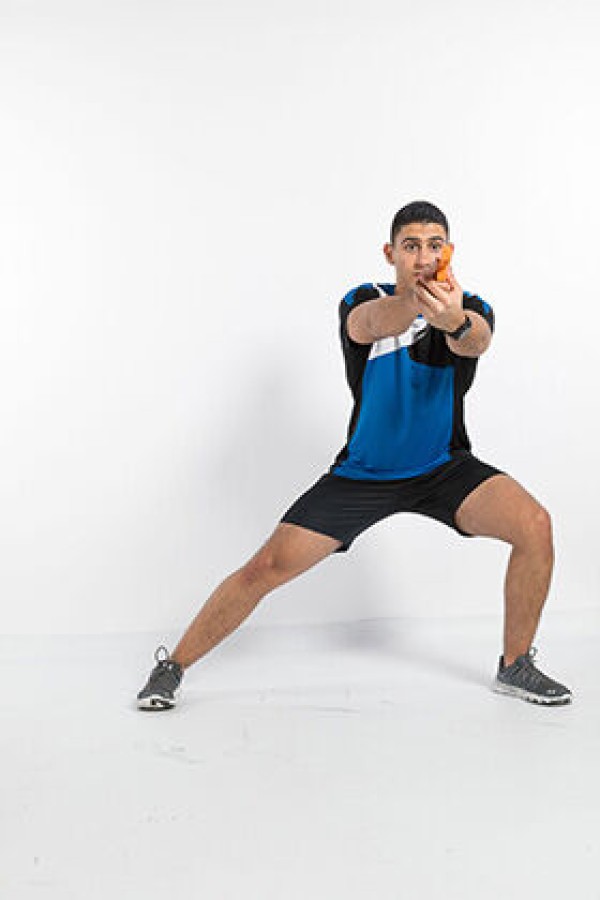
Standing lunge, lunge to the side in contact position with simultaneous bending of the legs and lowering of the upper body to move sideways and return to the standing position (movement as if you were ducking under a height limit). The next exercise is performed in the opposite direction so that you are back at the starting position.
Lighten:
Bend your knees less/barely lower your body.
Harden:
Bend your knees more/Centre of gravity very low.
1 Pistol
Lunge sideways alternating ► lateral lunge
Power
Individual work



Standing lunge, lunge to the side in contact position with simultaneous bending of the legs and lowering of the upper body to move sideways and return to the standing position (movement as if you were ducking under a height limit). The next exercise is performed in the opposite direction so that you are back at the starting position.
Lighten:
Bend your knees less/barely lower your body.
Harden:
Bend your knees more/Centre of gravity very low.
1 assault rifle (neutralised)
Lunge sideways alternating ► lateral lunge
Power
Individual work



Stand upright with hips wide apart, lunge to the side (leg outstretched, standing leg bent), lower your upper body and touch the floor with your hands on your bent standing leg, push off your bent leg to return to the starting position. Switch sides after each exercise.
Attention:
Keep your upper body upright, keep the knee of the supporting leg centred over the foot, put weight on the whole foot.
Lighten:
Bend the training leg less (lower your upper body less, rest your hands on your hips).
Harden:
Add weight (on the shoulders, with hanging arms or in a forward or upward position).
Variant:
Place carpet remnants/felt slippers/glides under the feet to slowly slide the respective leg to the side.
1 weight vest/weight disc/(medicine) ball/barbell/sandbag/fighting backpack/2 dumbbells ► make the exercise more difficult (additional weight)
2 carpet remnants/felt slippers/gliders ► variation of the exercise
Lunge sideways alternating ► lateral lunge
Power
Individual work


Stand upright shoulder-width apart, feet in the loops, hold the gymnastics pole in front of the body with bent, parallel forearms (baby position), lunge to the side (leg stretched out, supporting leg bent), push off the bent leg to return to the starting position. Switch sides after each exercise.
Attention:
Keep your upper body upright, keep the knee of the supporting leg centred over the foot, put weight on the whole foot.
Lighten:
Choose less strong elastic bands; roll up the elastic bands less; bend the training leg less (lower the upper body less).
Harden:
Choose stronger elastic bands; roll up the elastic bands more.
1 gymnastic bar with elasticated straps
Lunge sideways alternating ► lateral lunge
Power
Individual work


From an upright shoulder-width stance with the dumbbells held in the hanging arms, perform a lunge to the side (leg outstretched, supporting leg bent). Then push off the bent leg to return to the starting position in the standing position. Switch sides after each exercise.
Starting position:
- Stand shoulder-width apart
- Your back is straight
- Let your arms hang loosely, grasp the dumbbells in a neutral grip
Finishing position:
- Back remains straight
- Look straight ahead
- Leg to be trained is bent, the other leg is stretched out to the side
- Buttocks point backwards, do not bring the knee of the training leg forwards (does not protrude beyond toes)
- Keep the knee of the supporting leg centred over the foot, put weight on the whole foot
- Thigh of the bent leg is parallel to the floor
- Dumbbells (almost) touch the floor
2 dumbbells
Lunge forwards alternating ► farmer walk
Power
Individual work

Grab an object with both hands (approx. 10kg), arms hanging at your sides. Carry objects back and forth between two fanjons, moving with lunges (back knee just touching the floor).
Attention:
Keep your back straight, your pelvis stable with every step, keep your shoulders fixed (lower towards your hips).
Lighten:
Equipment approx. 5kg
Harden:
Equipment approx. 15kg
2 fanjons
Weight 10kg
Weight 5kg ► make the exercise easier
Weight 15kg ► make the exercise more difficult